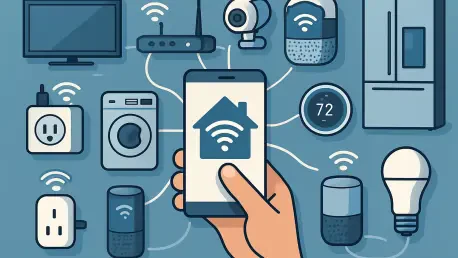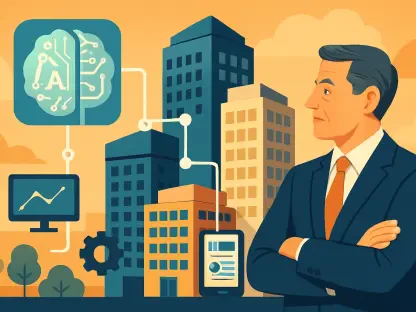Imagine stepping into a home where the lights automatically dim to match the evening ambiance, the thermostat adjusts to your preferred temperature before you even arrive, and the security system sends real-time alerts about unusual activity—all without any manual input. This isn’t a distant dream but a tangible reality shaped by residential Internet of Things (IoT) devices, which are revolutionizing modern living. By 2031, these connected technologies are projected to redefine the very essence of what a home represents, transforming it into a space that’s not only smarter but also more efficient and personalized to individual needs. From smart lighting to intelligent appliances, the integration of such innovations promises a future where convenience and control are at the forefront of daily life. Drawing on insights from a detailed market analysis, this exploration delves into the trends, technological advancements, and external forces driving this transformation, while also addressing the challenges and future possibilities that lie ahead through the next six years.
Driving Forces Behind Smart Home Evolution
The surge in popularity of smart home technologies stems from a universal craving for ease and efficiency in managing daily routines. Devices like smart thermostats, lighting systems, and security cameras allow homeowners to oversee their environments remotely through intuitive smartphone apps or simple voice commands. This growing adoption isn’t merely a fleeting fad but a reflection of a broader societal shift toward digital connectivity, where having an internet-enabled home is becoming as fundamental as having running water or electricity. The appeal lies in the ability to save time, reduce energy waste, and enhance safety, making these tools indispensable in modern households. As the market expands through 2031, expect an even deeper integration of such systems, creating living spaces that are more responsive and adaptable to changing lifestyles across diverse demographics.
Another critical factor propelling this market forward is the rapid pace of technological innovation that continues to enhance the functionality of IoT devices. Developments in connectivity protocols, such as Wi-Fi 6 and Zigbee, have significantly improved the reliability and seamless interaction between various gadgets within a home ecosystem. Simultaneously, the decreasing cost of essential components like sensors and microcontrollers has democratized access to these technologies, moving them beyond the realm of luxury and into the hands of middle-income families and tech enthusiasts alike. This affordability drives competition among manufacturers, fostering a cycle of innovation that introduces new features and better user experiences. By 2031, such advancements are likely to make smart home setups a standard feature in most residences, fundamentally altering how living spaces are designed and utilized.
External Influences Accelerating Adoption
Government policies and incentives aimed at promoting energy efficiency play a substantial role in accelerating the uptake of residential IoT devices. Many regions are implementing tax credits, rebates, and smart city programs that encourage the installation of connected systems like smart HVAC controls and energy meters, which help reduce consumption and environmental impact. These initiatives align with global sustainability goals, making it financially attractive for homeowners to invest in technologies that contribute to smarter, greener living. As these supportive frameworks expand over the coming years, they are expected to catalyze widespread adoption, embedding IoT solutions into the fabric of urban and suburban development by 2031, and reshaping community infrastructure to prioritize efficiency and connectivity.
In parallel, the pervasive availability of smartphones and high-speed internet has become a cornerstone for the seamless operation of IoT ecosystems in homes. These tools enable users to interact with their devices effortlessly, whether adjusting a thermostat from a workplace or monitoring a security feed while on vacation. The ubiquity of mobile connectivity ensures that managing a connected home is no longer a complex task but a straightforward extension of everyday digital habits. This trend is set to intensify as internet infrastructure continues to improve globally, particularly in developing regions, making remote control and real-time updates a norm rather than an exception. By 2031, this enhanced accessibility will likely solidify the role of IoT devices as essential components of household management, bridging geographical distances with ease.
Future Trends: AI and Sustainability in Focus
Looking ahead, artificial intelligence (AI) is poised to become a game-changer in the realm of residential IoT, offering a level of personalization and automation previously unimaginable. Picture a home that not only reacts to commands but anticipates needs—adjusting room temperatures based on past patterns or suggesting optimal energy usage to cut costs. Leading companies are already rolling out AI-driven platforms that enhance user experiences through predictive capabilities, setting the stage for homes that truly adapt to their occupants. As these technologies mature by 2031, they are expected to become standard, turning residences into intelligent environments that learn and evolve, providing tailored comfort and efficiency without compromising on simplicity or accessibility.
Sustainability is another pivotal trend shaping the future of connected homes, driven by both consumer demand and regulatory pressures. Smart devices that monitor and optimize energy usage, such as advanced thermostats and power meters, are becoming vital tools in reducing carbon footprints and aligning with environmental priorities. These solutions not only appeal to eco-conscious individuals but also benefit from government-backed incentives that promote greener living. Over the next several years, this focus on sustainability is likely to intensify, with IoT technologies playing a central role in achieving global climate goals. By 2031, homes equipped with such systems could significantly contribute to energy conservation, reflecting a collective shift toward responsible consumption and long-term ecological balance.
Addressing Challenges for a Seamless Future
As the number of connected devices in homes multiplies, concerns about data privacy and security are becoming increasingly prominent, necessitating robust solutions. Industry leaders are prioritizing the development of enhanced security protocols to protect user information and prevent unauthorized access, ensuring trust in these technologies. Recent certifications and updates to smart appliance platforms demonstrate a commitment to safeguarding personal data, addressing one of the most pressing barriers to adoption. By 2031, advancements in encryption and authentication are expected to mitigate these risks, creating a secure digital environment where homeowners can confidently embrace the full potential of IoT without fear of breaches or vulnerabilities.
Equally important is the challenge of interoperability among diverse IoT devices, which can often operate on different standards or platforms, leading to fragmented user experiences. Efforts to create universal compatibility frameworks are gaining traction, with major players investing in solutions that allow seamless communication between gadgets regardless of brand or type. This focus on integration aims to simplify the management of multiple devices, making smart homes more user-friendly and cohesive. As these initiatives progress through 2031, the vision of a fully interconnected home—where every device works in harmony—should become a reality, eliminating technical hurdles and enhancing overall functionality for users worldwide.
Reflecting on a Connected Legacy
Reflecting on the journey of residential IoT devices, it’s evident that their impact had already begun to redefine domestic spaces well before 2031 arrived. Technological strides, coupled with supportive external factors, laid a foundation that turned homes into hubs of efficiency and intelligence. The emphasis on AI, sustainability, and security shaped a landscape where convenience was matched by responsibility, ensuring that innovation served both individual needs and broader societal goals. As challenges were met with ingenious solutions, trust in these systems grew, embedding them deeply into everyday life. Looking back, the next steps involved continuous collaboration among industry stakeholders to refine interoperability and privacy measures, while policymakers expanded incentives for sustainable tech adoption. This legacy of progress pointed toward an enduring transformation, urging a focus on scalable, inclusive advancements to carry the momentum of connected living into future decades.









